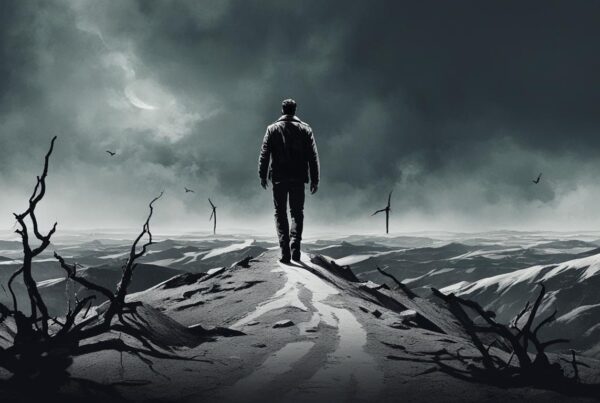Stepping into the pages of Erik Larson’s historical thriller, “The Devil in the White City,” readers find themselves transported to the grandeur and grim reality of the 1893 World’s Columbian Exposition. Larson expertly juxtaposes the ambitious fervor of Daniel Burnham, the fair’s chief architect, against the dark exploits of H.H. Holmes, America’s first urban serial killer. This audiobook review delves into a work that is as much a vivid tapestry of Chicago’s World’s Fair as it is a chilling dive into the mind of infamy.
At once a triumph of diligent research and narrative flair, Larson’s book fleshes out a pivotal moment in history with the suspense of a true crime novel, providing a unique listening experience for those who prefer the audiobook format. Whether uncovering the architectural wonders of the fair or revealing the macabre details of H.H. Holmes’s infamous “Murder Castle,” this work ensures that the 1893 World’s Columbian Exposition is remembered for both its awe-inspiring achievements and its harrowing shadows.
An Intriguing Synthesis of Historical Fact and Gripping Narrative
Erik Larson’s mastery of blending historical narrative with the magnetism of creative nonfiction sets “The Devil in the White City” apart as a singular reading experience. Larson uses compelling literary techniques and meticulous research to craft a work that keeps readers on the edge of their seats, infusing suspense in literature with real-world historical events. This section delves into how Larson’s approach blurs the lines between fact and fiction, while still respecting the integrity of historical truth.
Blending Reality with Fiction
Larson’s novelistic recounting of the events surrounding the Chicago World’s Fair demonstrates his unique ability to combine rigorous factual research with enthralling narrative. The author orchestrates a dance between the dry facts of history and the colorful flourishes of storytelling—each step carefully measured to ensure the integrity of the historical record while engaging the reader’s imagination.
Author Erik Larson’s Unique Approach
Employing a journalist’s eye for detail and a novelist’s sense of drama, Larson layers his account with rich contextual descriptions, character development, and plot progression. The juxtaposition of Daniel Burnham’s architectural ambition against H.H. Holmes’s dark schemes is particularly potent, showcasing Larson’s skill in presenting dual narratives with equal intensity and depth.
The Fine Line Between History and Storytelling
In “The Devil in the White City,” the line between history and storytelling is not just fine—it’s imperceptible at times. Larson doesn’t merely present historical facts; he interprets them, weaves them into a cohesive and fascinating tapestry that reads with all the engagement of a classic novel. This literary approach asks readers to reflect on the nature of truth and the ways in which stories can inform and transform our understanding of the past.
Setting the Scene: The 1893 World’s Columbian Exposition
In 1893, Chicago unveiled the World’s Columbian Exposition, a gathering that showcased the zenith of human ingenuity and cultural aspirations of the age. It was an event where technological advancements, architectural innovation, and cultural exchanges intersected, leaving a lasting imprint on the global stage. The fair’s breathtaking “White City” became a symbol of progress and the picturesque landscape that housed it, a canvas for the cultural impact and global influence that would ripple out into the new century.
The Architectural Marvel of the “White City”
Christened as the “White City” due to its gleaming white buildings, the site was an expanse that redefined architectural elegance. Its neoclassical structures not only displayed the pinnacle of design aesthetics of the era but also symbolized the emergence of a nation poised to take its place on the world’s cultural and economic stage. The fair was a palette of magnificent structures that revealed the burgeoning American architectural talent and the technological prowess that made such grandeur possible.
The Fair’s Role in American Progress
The Columbian Exposition served as a crucible for American ingenuity and ambition, accelerating the nation’s trajectory towards modernity. The exposition was not just a showcase of progress; it was an engine that drove technological advancements forward, introducing many to electricity, engineering marvels, and consumer products that would eventually become everyday staples.
Innovations and Attractions that Captivated the Nation
Below is a detailed account of the key inventions and attractions that left fairgoers in awe, underscoring the exposition’s global influence and its role as a showcase for cultural development:
| Innovation/Attraction | Description | Impact |
|---|---|---|
| Ferris Wheel | Engineer George Washington Gale Ferris Jr. debuted his 264-foot-tall wheel. | Symbolized America’s capacity for large-scale engineering feats. |
| Electricity | Buildings and grounds dazzled with electrical illumination, a marvel at the time. | Propelled the adoption of electric light and power across the United States. |
| Street of Cairo | A recreation of an Egyptian street, adding international cultural elements. | Fostered cultural curiosity and international appreciation. |
| Diesel Engine | Rudolf Diesel introduced his efficient, compression ignition engine. | Revolutionized industry and transportation with its efficiency. |
| Teleautography | Forerunner to the fax machine, this innovation transmitted handwriting over distances. | Previewed the potential for remote communication in business and personal affairs. |
This exposition not only marked a pivotal moment in Chicago’s history but also in the cultural and technological progress of the nation, leaving a legacy that would extend far beyond its six-month tenure.
The Darkness Lurking in the Shadow of Progress
As the 1893 World’s Columbian Exposition showcased the pinnacle of progress and ingenuity, a nefarious underbelly thrived in its shadows. The spellbinding murder mystery of H.H. Holmes’s “Murder Castle” stands as a stark reminder of the dark history that creeped alongside technological brilliance.
The fair’s dazzling marvels drew the attention of millions, but it was H.H. Holmes who exploited the event’s chaos for sinister purposes. Masterfully blending criminal psychology and cunning, Holmes constructed a building that was part convoluted hotel, part charnel house. This structure, later known infamously as the “Murder Castle,” became the site of numerous unspeakable acts.
Larson’s work delves deeply into this juxtaposition of light and darkness, innovation and deception, leading readers down a path into the psychology behind America’s first serial killer. Below, we lay out the striking contrasts between the Exposition’s grandeur and the heinous machinations of Holmes’s world.
| World’s Columbian Exposition | H.H. Holmes’s “Murder Castle” |
|---|---|
| Symbol of advancement and hope | Epitome of human depravity |
| Architectural marvels on display | Labyrinthine passages designed for murder |
| Innovations celebrated worldwide | Gruesome procedures hidden from view |
| The bright future of a modern America | The darkest aspects of the human psyche |
In a period brimming with anticipation for the future, H.H. Holmes constructed a narrative that was equally fascinating and horrifying, etching his name into history through acts that gave a new dimension to the term ‘murder mystery.’ Larson captures this duality with a nuanced understanding, presenting a chapter of American history that is as compelling as it is macabre.
The Dual Narratives of Genius and Insanity
Erik Larson’s “The Devil in the White City” presents the Gilded Age as a period of intense societal transformation, showcasing two vastly contrasting protagonists whose stories unfold in tandem – each a psychological portrait unraveling the extreme spectrums of human capability.
Portrait of the Architect Daniel Burnham
Responsible for the grandeur of the Chicago World’s Fair, Daniel Burnham epitomizes the era’s ingenuity and determination. Burnham’s figure in the audiobook is etched as an embodiment of progress, his ceaseless ambition mirroring the bustling energy of a rapidly evolving America.
The Terrifying Charisma of H.H. Holmes
Contrasting the noble aspirations of Burnham, H.H. Holmes’s persona is inked with the hallmarks of malevolence. His charming deceit and calculated maleficence within the audiobook serve as a dark mirror to the splendor and idealism of the age, revealing a sinister facet of the human spirit.
How Both Men Embodied the Spirit of Their Age
The audiobook delves deep into how both Daniel Burnham and H.H. Holmes, each in their distinct ways, capture the essence of the Gilded Age – a period marked by monumental achievements and grotesque transgressions, framing a complex narrative of societal transformation.
| Daniel Burnham | H.H. Holmes |
|---|---|
| Architect of Progress | Architect of Evil |
| Symbol of Industrial Spirit | Emblem of Underlying Darkness |
| Driven by Public Vision | Driven by Personal Deceit |
| Legacy of Landmarks | Legacy of Scandal |

Unmasking H.H. Holmes: America’s First Serial Killer
The ghoulish tale of H.H. Holmes, often recognized as America’s first serial killer, is a profound chapter in the annals of historical true crime. His sociopathic behavior has left a grim footprint in the field of criminal investigations. The fusion of early forensic science in piecing together the depth of his atrocities marked a turning point in law enforcement methodologies.
Echoing through time, the life and death of Holmes represent a critical case study in the development of modern criminal profiling and investigative techniques. Holmes’ capture is a precedent in the domain of crime-solving, illuminating the darkness of his crimes with the nascent spark of scientific inquiry.
Notorious for his charm and intelligence, H.H. Holmes exploited the vibrant atmosphere of the 1893 World’s Columbian Exposition to lure victims to his elaborately constructed ‘Murder Castle’. His bewildering array of traps, false rooms, and secret passages confounded both victims and eventually, the investigators.
In a reflection of the burgeoning capabilities of forensic science, Holmes’s eventual downfall was precipitated not only by the shrewdness of criminal investigators but also by advances in tracking and forensic methodologies. This convergence of skill and science has left an indelible impact, resulting in heightened public awareness and establishing new protocols in the identification and apprehension of serial offenders.
- The large-scale and meticulous nature of criminal investigations launched to apprehend Holmes laid foundational practices still echoed in modern detective work.
- The case pushed the development of crime scene management techniques, emphasizing the meticulous preservation and analysis of physical evidence.
- Through the Holmes investigation, law enforcement began to formalize approaches for systematically tracking and apprehending serial criminals, which evolved into the sophisticated profiling systems used today.
As a dark token of America’s Gilded Age, the nefarious actions of H.H. Holmes catapulted sociopathic behavior into the public consciousness and impressed upon the nation the grave necessity for methodical criminal investigations. His tale, steeped in deception and cruelty, remains a pivotal example of the evolution of forensic science in the pursuit of justice.
Audiobook Review: Storytelling That Transports the Listener
The impact of an audiobook performance is often measured by its ability to draw listeners into the narrative, creating an immersive listening experience that rivals the depth and engagement of traditional reading. Erik Larson’s “The Devil in the White City” exemplifies this through a masterful narrative voice and deft auditory storytelling, vividly bringing to life the dual stories of an architect’s dream and a serial killer’s nightmare.
The Impact of Narration on the Tale’s Haunting Power
The choice of narrator for an audiobook can make or break its success. In “The Devil in the White City,” the narrator’s haunting delivery amplifies the suspense of the tale. Each inflection and pause is meticulously crafted to echo the tension and gloom pervading the story’s atmosphere. It is a testament to how a skilled narrative voice can articulate the emotional undercurrents of a story, underlining moments of fear, awe, and despair in ways that resonate deeply with listeners.
Soundscapes and Audio Immersion in Historic Events
What sets apart audiobooks like Larson’s is the layering of soundscapes that envelop the listener, creating a sense of place and time that is specific to the historic events detailed within. The murmurs of a crowd at the Chicago World’s Fair or the ominous silence of Holmes’ abode are brought to life, providing an auditory dimension to the storytelling that is sometimes lost in print.
Comparing the Audiobook Experience to Reading
While reading allows one to imagine the scenes and characters in their own mind, listening to an audiobook offers a distinct interpretation, guided by the timbre and rhythm of the narrator’s voice. The experience is akin to a performance, where the listener is privy to the intricacies of characterization and narrative flow through auditory cues. This difference is particularly notable in “The Devil in the White City,” where the horror and grandeur of the events described benefit from the immediacy and intimacy of being told aloud.

Evaluating Erik Larson’s Research and Fidelity to History
The quest for historical accuracy in literary works is often a rigorous endeavor, marked by meticulous research and an unwavering dedication to the truth. Erik Larson’s commitment to these principles is evident throughout his works, showcasing nonfiction storytelling that resonates with the authenticity of literary journalism. This adherence to factual representation cements Larson as a paragon in the realm of historical literature.
Larson’s investigative process involves delving into vast archives and intimate diaries, extracting the most minute details to present a narrative that is both informative and captivating. The balancing act between an engaging narrative and the upholding of factual integrity is a hallmark of his writing. Through a combination of intuitive narratives and an uncompromising respect for the source material, Larson enlivens past scenarios, transforming fragments of history into a vivid tableau for the modern reader.
To gauge the extent of Larson’s dedication to presenting an accurate historical narrative, one can scrutinize the various aspects of his work with a critical eye:
| Component | Description | Impact on Narrative |
|---|---|---|
| Primary Sources | Larson’s reliance on diaries, letters, and newspapers from the era. | Provides an authentic voice and context to the events described. |
| Setting Depiction | Illustrative descriptions of locations, attire, and societal norms of the time. | Creates an immersive atmosphere that transports the reader to the historical period. |
| Character Portrayal | Complex, multi-dimensional representations based on documented behaviors and testimonies. | Enhances readers’ connection with historical figures, presenting them as relatable individuals. |
| Fact-Checking | Rigorous verification of facts and data presented in the narrative. | Ensures the reliability of the account and builds trust with the reader. |
The result of such thorough research is a body of work that not only educates but also enthralls, making historical events and figures accessible to a broad audience. Larson’s diligent approach to sourcing and assembling his narratives stands as a commendable example of the symbiotic relationship between historical fidelity and compelling storytelling.
Through meticulous detail and scrupulous verification, Larson transforms historical research into a tapestry of intrigue and enlightenment, holding a mirror to the past with a clear and engaging reflection.
Themes of Ambition, Vision, and the Nature of Evil
In “The Devil in the White City,” Erik Larson masterfully dissects the intricate themes of human ambitions and the consequential moral dilemmas that arise when lofty utopian dreams encounter the stark reality of inherent evil. The late 19th century, with its rapid societal advancements and moral upheavals, serves as a vibrant canvas on which Larson paints the dichotomies of the era’s zeitgeist—the yearning for greatness and the inescapable shadow of the basest human behaviors.
Ambition in the Gilded Age: Insight into Human Drive
The epoch known as the Gilded Age was rife with the energy of newfound human ambitions. Daniel Burnham’s architectural aspirations epitomize the era’s relentless pursuit of excellence and the transformative power of vision. His architectural accomplishments for the Chicago World’s Fair are depicted as not simply structures of steel and glass, but as embodiments of an age’s spirit and its tenacious push towards progress.
Visions of Utopia Against the Backdrop of Horror
Larson contrasts these utopian dreams with a reality marred by the chilling narrative of H.H. Holmes, whose grisly deeds unravel within the fair’s luminous embrace. The fair’s grandeur is continually set against Holmes’s macabre actions, posing philosophical questions of ethics that probe the duality of progress and the potential for darkness that lies beneath the surface of innovation and advancement.
Philosophical Exploration of Evil Through H.H. Holmes’s Crimes
This alarming juxtaposition extends beyond mere chronicle to become a philosophical exploration of the nature of evil itself. Holmes’s crimes offer a harrowing glimpse into the abyss of human depravity, challenging the society’s notions of morality. As Larson delves into the psyche of America’s first serial killer, he lays bare the broader existential and societal implications of Holmes’s heinous acts—a disturbing reminder that within the same environment where some strive to construct utopian dreams, others may foster nightmares.



